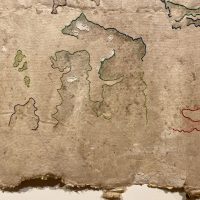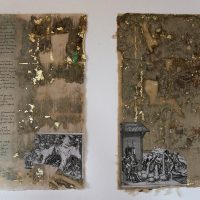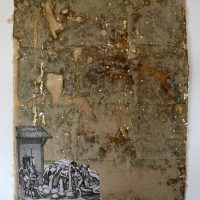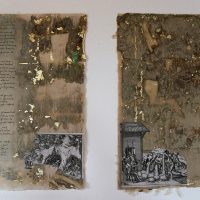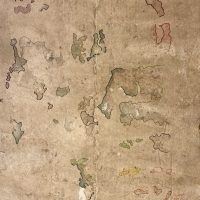
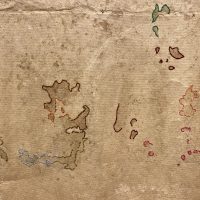

Oro no es/ Gold, is it not?
By Joy Sperling
Micaela de Vivero was born in Munich, Germany and grew up in Quito, Ecuador. She graduated from the Universidad San Francisco de Quito and received an M.F.A. from Alfred University in New York. She now lives, teaches, and has an art practice in the United States. She travels globally to work and exhibit her sculpture, in part to fulfill a commitment to making transcultural artistic connections that are foundational to her intellectual artistic practice. Intersectionality suffuses and informs Vivero’s sculpture . Her art supports Stuart Hall’s contention that diasporic subjects “speak, sing, and write so eloquently” (171) because they:
“learn to inhabit more than one identity, dwell in more than one culture, and speak in more than one language….[Their] cultural identity is always something, but it is never just one thing: such identities are always open, complex, under construction, taking part in an unfinished game…[T]hey move into the future through a symbolic detour through the past.” (173-4)
Moreover, a single visual object in one of Micaela de Vivero’s pieces can “mean” in multiple ways, both in space and in time. Meaning and message, image and emotion are unfixed and unstable, “delinked” from the norm and function as slippery and multi-accented “sliding signifiers” in Hall’s sense. Micaela de Vivero’s art is interlaced with echoes of her lived history in Ecuador, her understanding of and empathy with Latin American history and her transactions with today’s globalized culture and economy, as well as by her other lived histories in her homes in the United States and around the world. Her work is also clearly situated within decolonial theory. There is no quick or easy way to address the wreckage left by colonial powers globally, but one of the most significant prevailing theories is that of decoloniality, which has emerged in Latin America. It posits that the only possible way to repair societies fundamentally damaged by colonialism in the ‘Global South’ is not to overthrow or negate the colonial matrices of power but to “delink” them from the colonial paradigm—to challenge Eurocentrism and all of its assumptions, including the concepts of Modernity and Modernism—and to interrogate each local structure as it is “delinked” from the colonial. Thus, while larger global systems of power and commerce must be challenged, so too must local systems such as religion, ethnicity, gender, class, and even regionality.
Starting during the COVID-19 lockdown, Micaela de Vivero has made a number of large handmade-paper murals from dry Abaca pulp (leaves of a banana tree) and flax pulp (linseed and the basis of linen fiber), which she moistens with water and layers on large screens to make very large murals. The process is complicated and time consuming. The images produced have an innate sense of fragility and instability, having been created in an atmosphere of unreality and uncertainty—of being locked at home, fearing for herself and her family (close by and afar), for the present and the future, experimenting with new ideas and new crafts alone with limited access to materials, equipment, and external expert advice or assistance, and left to the mercies of time and changes in temperature and humidity. And, unlike manufactured paper, they are inherently fragile objects often subject to cracking and tearing. Paper bears cultural meaning: it is a medium upon which humans have written for centuries; power has been accorded to those with either the ability or need to write in history; the handwritten page holds significance; it facilitates the mapping of the known and unknown. Early maps were not only the means by which we found our way around the world, but they were the way nations claimed ownership of places—by drawing parts of the New World, the Spanish, the Dutch, the French, and the English claimed parts of it as their own, regardless of who lived there before them. German naturalist Alexander von Humboldt who, although he made a self-funded scientific exploration of Latin America in 1800, was granted an audience by Charles IV of Spain before his expedition and was granted passports, travel permits, and powerful letters of introduction that enabled him to impose the most extensive European cartography and typology on the places, peoples, and plants of Latin America to create a series of systems and structures that have proven almost impossible to retract. The mapping of Latin America exponentially increased the search for gold and other raw materials as well as the exploitation of indigenous labor immediately after the widespread publication of Von Humboldt’s maps. Mapping holds particular significance in Vivero’s work.
In Contested Territories, a large multi paper mural,Vivero extends this narrative to focus specifically on mapping as a symbolic act of possession. The surface of Contested Territories is punctuated by a series of open-ended forms that are partly drawn with thread on the surface of hand-made paper and partly painted in washes of soft colors. These forms appear like incomplete islands or as islands that appear to rise from the ocean and fall back into it with tidal changes or climate change. They suggest the fleeting nature of territorial possession and, by extension, colonial power in geological history. Once again, Vivero asks the viewer to consider the complicated and many-layered question of possession and power and the hubris of claiming sovereignty over “undiscovered” land and its indigenous people. The map is edged in (fake) gold; its rough outline and natural-colored paper suggest an old, long surviving, or valuable map that has some significance. There is no key to any of Vivero’s maps. Nothing within them is identified—their meaning is encoded, hidden, and deferred. Yet, we sense that these maps are about acquisition and repression: the presence of gold robs them of their innocence and thrusts them into the Western orbit in which money (in the form of gold) equals power. Today, more than ever, we associate gold with power, aggression, and display (often ostentatious displays of power in the form of conspicuous consumption). Even the color gold has been debased. Too much gold feels gaudy, excessive, and unreal. Perhaps that is why it is important to her that her gold is not real: it tarnishes, it is half hidden, and it is intimately just copper, which may have high use-value but has very low exchange-value.
Joy Sperling is professor emerita of Art History and Visual Culture at Denison University. She is currently finishing a book on women artists in the American Southwest 1910-1950. But most recently, she has written on women sculptors for Hyperallergic, Art Critical, and for the Figge Museum, IA.
Micaela de Vivero
e-mail: micaelavive@hotmail.com
Education:
| 1999 | Alfred University, Alfred, NY, USA Master of Fine Arts / Sculpture |
| 1996 | Universidad San Francisco de Quito, Quito, Ecuador Baccalaureus Artium / Arts |
Grants/Awards
| 2020 | Denison University, USA Durf Grant Recipient (2020, 2019, 2018, 2017, 2016, 2015, 2014, 2013, 2012, 2011, 2010, 2008, 2007) |
| 2017 | Denison University, USA R.C. Good Faculty Fellowship |
| 2015 | Andy Warhol Foundation for the Arts, USA Grant through New Genre Arts Festival, Tulsa, OK |
Solo Exhibitions
| 2021 | Olin Art Gallery Washington & Jefferson College, Washington, PA, USA “The You and the I,” Sep 10 – Oct 15 Gallery 310 Marietta College, Marietta, OH, USA “Oro no es/ Gold, is it not?” Aug 30 – Sep 30 Acropolis of Kavala, Greece “Current,” Aug 7 – 13 |
| 2019 | CERES Gallery, Chelsea, NY, USA “and on a windy day it got caught on a tree ,” June 25- July 20 |
| 2017 | Atelier Cézanne, Aix-en-Provence, France “Learning from Cézanne’s Sainte-Victoire,” Dec 4 – 29 CERES Gallery, Chelsea, NY, USA “Limbs,” May 23-June 17 |
| 2016 | Kansas City Artists Coalition, Kansas City, MO USA “The You and the I,” October 7 – November 4 Pentasiete, Quito, Ecuador “Oro no es,” January 7-15 |
| 2015 | Graven Feather, Toronto, Canada “Germinating Brick,” July 2 – 25Living Arts, Tulsa, OK, USA “The You and the I,” March 6 – April 23 |
| 2014 | CERES Gallery, Chelsea, NY, USA “The You and the I,” April 29 – May 24 |
| 2012 | CERES Gallery, Chelsea, NY, USA “There is always a part of sky to soar,” June 19 – July 14 |
| 2011 | El Museo Francisco Oller y Diego Rivera, Buffalo, NY, USA “(Im)possible Interventions”, September 16 – Oct. 28 |
| 2010 | CERES Gallery, Chelsea, NY, USA “nodes,” March 2- 27 |
Group Exhibitions
| 2021 | Howard County Center for the Arts, Ellicott City, Maryland, USA two person exhibition with Marcia Wolfson Ray, Aug 21 – Oct 2 Borders – Venice International Art Fair, Palazzo Albrizzi-Capello “Bodies + Cities,’ June 15 – July 04, 2021 2021 CERES Gallery, NYC, NY, “Outside My Ouvre,” Jan 6 – 30 | |
| 2019 | Galería en el Mercado Municipal, Rota, Spain Artistas de Agosto en PINEA – August 27 2019 Gallery 175, Pawtucket, Rhode Island, US Juried exhibition by the Art League of Rhode Island “Twisting Fibers; An Art for All Reasons,” March 8 – May 8 | |
| 2018 | Museu de Lanificios, Covilhã, Portugal “Montanha Mágica,” November 2-9 2018 Bowling Green State University, Bowling Green, Ohio, USA Juried exhibition part of Sculpture X symposium “Igniting Change,” August 31 – Sep. 29 | |
| 2017 | Denison Art Space, Newark Ohio, USA “Union Block,” Nov. 29, 2017 – Feb. 1, 2018 Riffe Gallery, Columbus, Ohio, USA 2017 Biennial Juried Exhibition, Nov. 2, 2017 – Jan. 6, 2018 | |
| 2016 | The University Gallery Eastern Michigan University, Ypsilant MI, USA “New Fibers 2016,” Oct 26 – Dec 7 Dedo Maranville University Gallery Valdosta State University, Valdosta GA, USA “Material Transformation,” Sep. 19 – Oct. 7 2016 Ceres Gallery, Chelsea, NY “Summer Celebration,” June 22 – July 16 | |
| 2014 | Water Tower Art Festival, Sofia, Bulgaria, June 20 – 25 Art Access Gallery, Columbus, OH, USA “From Another Place,” Jan. 31 – March 1 | |
| 2013 | Carnegie Gallery, Columbus Met. Library, Columbus, OH “Seis Latinas,” September 25 – October 18 Portas Abertas, Forum Eugenio de Almeida, Evora, Portuga July 11 – Oct 6 | |
| 2012 | Bienal de Arte Contemp. Argentina, Buenos Aires, Argentina Centro Cultural Borges, Oct. 3-10 FiberPhiladelphia, Philadelphia, PA, USA International biennial for innovative fiber/textile art Crane Arts Building, Icebox Project Space “Outside Inside the Box”, March 2 – April 12 Saratoga Arts Center, Saratoga Springs, NY, USA “Time.space.place.” Feb. 4 – March 31 | |
| 2011 | XVth Alternative Art Festival, Yerevan, Armenia Armenian Center for Contemporary Experimental Art, April 8-23 Ohio Art League, Columbus, Ohio “Espejismos (Mirages),” August 4 – 27 | |
| 2010 | Urban Institute for Contemporary Arts, Grand Rapids, MI ArtPrize, September 22 – November 20 Centro de Historia, Zaragoza, Spain “Quito en Zaragoza,” June 9 – September 5 Art Access Gallery, Columbus, OH, USA Two person show with Elena Oesterwalder and music performance by Randall Harrison “Junctions,” May 4 – 31 Fort Hayes Shot Tower Gallery, Columbus, OH, USA Ohio Art League Spring Juried Exhibition, March 2 – April 27 Queens Museum of Art, Queens, NY, USA “Ecuadorian Renaissance in NY 2010,” January 16- 31 | |
| 2009-2010 | Ohio Visual Artists Registry Annual Juried Show, Columbus Metropolitan Library, Columbus, OH, USA November 9, 2009 – January 3, 2010 | |
Publications
| 2021 | Catalog of exhibition: Oro no es/ Gold, is it not? https://static1.squarespace.com/static/60db3e2efa223049aedae333/t/612a473c76c97a1657bf5ad1/1630160705078/Oro+no+es_Gold%2C+is+it+not_+Micaela+de+Vivero.pdf 2021 Art Reveal Magazine, Issue 61 https://www.artrevealmagazine.com/61st/ 2021 Art Reveal Magazine – September 10 https://www.artrevealmagazine.com/solo-show-by-micaela-de-vivero-at-gallery-301/ 2021 Creative Quarterly 63 A Journal of Art and Design – page 14 2021 Creating Futures – Online Creative Community https://www.curatingfutures.com/post/artist-interview-micaela-de-vivero 2021 Artists Responding To – Issue 9 – page 22 https://www.artistsrespondingto.co.uk/zine?pgid=kp4f9wr1-0c2c078f-a43f-4aee-b2cd-4949648be807 | ||
| 2020 | The Mass – May 2020 – pages 75-78 https://www.the-mass.com/may-2020 | ||
| 2018 | Hyperallergic, June 29 https://hyperallergic.com/449534/a-view-from-the-easel-91/ igniting change – catalog of exhibition curated by Saul Ostrow part of Sculpture X symposium Bowling Green State University and https://hyperallergic.com/466699/sculpturex-igniting-change/ | ||
| 2017 | Columbus Dispatch, Dec. 17 http://www.dispatch.com/entertainmentlife/20171217/riffe-gallery-exhibit-features-variety-of-ohio-artists-approaches La Provence, daily newspaper, Aix-en-Provence, France “Venue apprendre de Cezanne” by Amandine ARRIGHI 12-Dec | ||
| 2016 | 2016 New Fibers 2016 – exhibition catalog A national survey of contemporary fiber art presented by the Fiber Arts Network of Michigan KC Studio http://kcstudio.org/micaela-de-vivero-kansas-city-artists-coalition/ by Sherée Lutz La Hora, daily newspaper, Quito-Ecuador, January 7 | ||
| 2015 | New Genre Arts Festival booklet, Tulsa OK, USA | ||
| 2014 | Studio Visit Magazine, Volume 28 Water Tower Arts Festival 2014 Catalog Sophia, Bulgaria Make8elieve – Issue 6: Mountains http://issuu.com/make8elieve/docs/m8-06, page 203 | ||
| 2013 | Columbus Dispatch, October 6 “Subtle imagery, tactile technique lift ‘Seis Latinas’ by Elizabeth Trapp | ||
| 2012 | New York Artists Online, December 22 “A Unique Exhibition: “Meet My Uterus” Catalog publication “1st Contemporary Art Biennial in Buenos Aires, Argentina” | ||
| 2011 | Catalog publication for gallery “Arte Actual” Quito-Ecuador Ecuador- 100 experimental audiovisual artists Editor: María Belén Moncayo (aanme) With support Prince Claus Fund for Culture & Development (The Netherlands) and the Ministry of Heritage (Ecuador) Columbus Dispatch, August 14 Exhibit Review/ Ohio Art League: Disconnetced feeling unites Latinas by Amy Davis |
Collections
| Museu de Lanificios, Covilhã, Portugal | |
| Bemis Center for Contemporary Arts, Omaha, Nebraska, USA | |
| Private Collections in the USA, Ecuador, Austria and Finland | |
| I have been a member of the Ceres Gallery in NYC since 2010. | |
| I am a member of the International Sculpture Center. | |
Residencies
| 2021 | PETRA AiR, Kavala, Greece (residency during July and August) |
| 2019 | PINEA-Linea de Costa, Rota, Spain (residency during August) |
| 2018 | Museu de Lanificios, Covilhã, Portugal (residency during April) |
| 2017 | Institute for American Universities, Aix-en-Provence, France (Resident Fellow from September – December) |
| 2016 | CAMAC, Marnay-sur-Seine, France (residency during June) |
| 2013 | Deutsche Börse Residency at Frankfurter Kunstverein Frankfurt, Germany (residency during June and July) |
| 2011 | Acoss, Yerevan, Armenia (residency during March and April) |
| 2007-2008 | RONDO, Marienmuehle, Graz, Austria (residency from October 2007 to February 2008) |
| 2007 | Koli Ryynanen, Koli, Finland (residency during May and June) |
| 2005 | Chretzeturm, Stein am Rhein, Switzerland |
